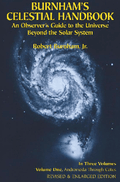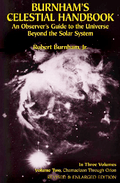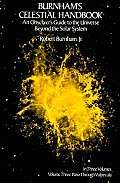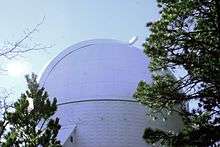Robert Burnham Jr.
| Robert Burnham Jr. | |
|---|---|
| Born |
June 16, 1931 Chicago, Illinois |
| Died | March 20, 1993 (aged 61) |
| Resting place | Fort Rosecrans National Cemetery |
| Nationality | American |
| Known for | Burnham's Celestial Handbook |
| Scientific career | |
| Fields | Astronomy |
| Institutions | Lowell Observatory |
Robert Burnham Jr. (June 16, 1931 – March 20, 1993) was an American astronomer, best known for writing the classic three-volume Burnham's Celestial Handbook.[1][2] He is the discoverer of numerous asteroids including the Mars crossing asteroid 3397 Leyla, as well as six comets.
Burnham's late years were tragic; he died destitute and alone. However, he is remembered by a generation of deep sky observers for his unique contribution to astronomy, the Celestial Handbook. The main-belt asteroid 3467 Bernheim was named in his honor.[3]
Early life and career
| Named Asteroids discovered: 1 [4] | |
|---|---|
| 3397 Leyla[1] | December 8, 1964 |
| |
| Comets discovered: 6 | |
| C/1957 U1 (Latyshev-Wild-Burnham)[1] | October 18, 1957 |
| C/1958 D1 (Burnham 1958a)[2] | 1958 |
| 56P/Slaughter-Burnham[3] | January 27, 1959 |
| |
Burnham was born in Chicago, Illinois, in 1931, the son of Robert Sr. and Lydia. His family moved to Prescott, Arizona, in 1940, and he graduated from high school there in 1949. That was the culmination of his formal education. Always a shy person, he had few friends, never married, and spent most of his time observing with his home-built telescope.[2]
In the fall of 1957 he received considerable local publicity when he discovered his first comet. This led to his being hired by Lowell Observatory in Flagstaff, Arizona, in 1958 to work on a survey of stellar proper motion using a blink comparator. While Burnham was working at Lowell, he and his co-worker, Norman G. Thomas, discovered five more comets (including 56P/Slaughter-Burnham), and in excess of 1500 asteroids.[2]
Burnham's Celestial Handbook
 Vol. 1 |
 Vol. 2 |
 Vol. 3 |
In addition to his regular duties at the observatory, Burnham spent almost all of his free time working on the Celestial Handbook. His writing and his book were never officially supported by Lowell Observatory.
Subtitled "An Observer's Guide to the Universe Beyond the Solar System," the Celestial Handbook combines a lengthy introduction to astronomy with catalog information for every constellation in the sky. Thousands of stars and deep sky objects visible in small telescopes are covered in meticulous detail.[2][5]
Originally self-published in a loose-leaf serial format beginning in 1966, and with a revised edition by Dover Publications in 1978, the Celestial Handbook was well reviewed in amateur astronomy magazines and became a best seller in this specialized field. It is still in-print and is considered to be a classic in the literature of amateur astronomy.[2]
Due to the popularity of Celestial Handbook, Tony Ortega writing in the Phoenix New Times in 1997 described Burnham as an author "whose name has become so familiar to some readers it has become a sort of shorthand, like Audubon to birders, Hoyle to card players, Webster to poor spellers, Robert to parliamentarians."[2] Ortega then described the book series as:
...a sort of real-life hitchhiker's guide to the galaxy, a compendium with something to say about nearly every cosmic destination worth visiting. Part travel guide, part history text, part encyclopedia, it's like a handheld natural history museum of the universe. And for decades it's held a grip on the imaginations of most people who ply the night skies with telescopes, people who yearn to travel in space and know that they can, any dark and clear night. Reading Burnham's massive, three-volume work is like reading the notes of an adventurer who has spent a lifetime studying the treasures of a lost civilization: Its 2,138 pages are loaded with tables of data, technical passages and illustrations interspersed with historical arcana and ancient poetry. And all of it is meant as an incentive for the reader to recover those treasures by merely looking upward. It is rarely compared to other books because there simply is none other like it. No other popular work approaches its utility and completeness; few other scientific texts contain its sense of wonder and even spirituality.[2]
Life after Lowell

In April 1979, the year after Celestial Handbook was published by Dover, Burnham received notice that the proper motion survey would soon be completed and that the observatory could not afford to keep him on in the position he had long held. Despite months of warning, he failed to make other arrangements and, after twenty-one years at Lowell, his job ended in December of that year. Unwilling to take the only position that was offered to him, that of janitor at the observatory, he left.[2]
Burnham was never able to recover personally, professionally, or financially after he lost the job at Lowell. Over the next few years, while sales of the Celestial Handbook were rapidly growing, Burnham's personal circumstances were steadily worsening. His shyness increased and he shunned all publicity, becoming even more reclusive. He bickered often with Dover about royalties and about the creation of possible new editions or translations of his book.[2] He also worked sporadically on a fantasy novel - which he never completed.[5]
Writing for the Frosty Drew Observatory in 2000, Doug Stewart said:
Had Burnham been a more astute businessman he might easily have parlayed his justifiable fame into a comfortable income. He would have been in great demand on the speakers' circuit, and could have held a top post in any planetarium in the country. He was actually quite a skilled speaker before such groups, a skill honed in over twenty years of observatory tours at Lowell. But this was not Robert Burnham, Jr. He continued to shy away from publicity, at the same time that he sought recognition for his work. His small income became less and less reliable, even while Dover's success with his guide increased (it was, and remains, a featured offering of the Astronomy Book Club).[5]
As his situation worsened, Burnham, who was never married,[5] become bitter and depressed, and isolated himself from his few friends and family. He had lived for a time in Phoenix, Arizona, but in May 1986 he left Phoenix and dropped out of sight completely, informing no one but his publisher of his whereabouts. Despite being the author of a successful book, Burnham spent the last years of his life in poverty and obscurity[5] in San Diego, California, selling his paintings of cats at Balboa Park. The fans of Celestial Handbook were likely unaware of his personal circumstances; possibly assuming that a different and unrelated Robert Burnham, an editor at Astronomy magazine, was the author.[2][6]
Naming of 3467 Bernheim
Norm Thomas, Burnham's former co-worker at Lowell Observatory, had told Burnham that he planned to name an asteroid after him. On September 26, 1981, Thomas discovered a main belt asteroid,[7] but since asteroid 834 Burnhamia, named after the unrelated 19th century astronomer Sherburne Wesley Burnham, already carried the name, a different spelling was needed. Thomas chose the spelling Bernheim, for the Burnham family's ancestral Bohemian surname.[7] Thus the asteroid named to honor Robert Burnham Jr. was named 3467 Bernheim.[8][9]
Death and posthumous "interview"

Burnham died destitute and alone at the age of sixty-one in 1993. His family did not learn about his death (apparently by his choice) until two years later, and didn't report it to the press even then because they were unaware of his stature in the amateur astronomy community.[2]
After his death, it was realized that he had often attended programs presented by the San Diego Astronomy Association (at the Ruben H. Fleet Space Theater in Balboa Park) without anyone recognizing him. In spite of the tragedy of his later years, Burnham continues to be remembered by a generation of deep sky observers for his unique Celestial Handbook. His cremated remains are interred at the Fort Rosecrans National Cemetery in San Diego, California.[2]
In 2009 a memorial consisting of a small bronze plaque resembling a page in Burnham's Celestial Handbook was installed on the Pluto Walk at Lowell Observatory.[10]
Burnham rarely gave interviews, but at the height of the popularity of Handbook in 1982, he wrote a piece where he playfully interviewed himself for the magazine Astronomy. A much longer version of this essay, An Interview with the author of The Celestial Handbook, dated April 1983, was discovered among Burnham's papers and it was first published in its entirety by The Village Voice in June 2011, 18 years after his death.[11] It was introduced as follows:
If Burnham's life ended in an unfortunate fashion, in the following essay you will meet the man at his most beguiling, a largely self-taught polymath who could be both playful and cantankerous. Nearly three decades since he put these words down, his ideas about progress, science and religion, and man's future in space still seem fresh. We hope you find his words illuminating.
Bibliography
Burnham's Celestial Handbook was originally self-published in a loose-leaf serial format beginning in 1966; it was issued in hardcover and later as a paperback in a three-volume, revised and enlarged edition by Dover Publications beginning in 1978.
- Burnham Jr., Robert (1978). Burnham's Celestial Handbook: An Observer's Guide to the Universe Beyond the Solar System, Volume One: Andromeda-Cetus (Revised & Enlarged ed.). New York: Dover Publications. ISBN 9780486235677.
- Burnham Jr., Robert (1978). Burnham's Celestial Handbook: An Observer's Guide to the Universe Beyond the Solar System, Volume Two: Chamaeleon-Orion (Revised & Enlarged ed.). New York: Dover Publications. ISBN 9780486235684.
- Burnham Jr., Robert (1978). Burnham's Celestial Handbook: An Observer's Guide to the Universe Beyond the Solar System, Volume Three: Pavo-Vulpecula (Revised & Enlarged ed.). New York: Dover Publications. ISBN 9780486236735.
References
- ↑ Jeffrey, Dale (1998). "Robert Burnham Jr.: Gone But Not Forgotten". Journal of the Royal Astronomical Society of Canada. 92: 18–19. Bibcode:1998JRASC..92...18J. Retrieved 2016-01-11.
- 1 2 3 4 5 6 7 8 9 10 11 12 Ortega, Tony (1997-09-25). "Sky Writer". Phoenix New Times. Retrieved 2016-01-11.
- ↑ Schmadel, Lutz D. (2007). Dictionary of Minor Planet Names – (3467) Bernheim. Springer Berlin Heidelberg. p. 290. ISBN 978-3-540-00238-3. Retrieved 14 November 2016.
- ↑ "Minor Planet Discoverers (by number)". Minor Planet Center. 4 September 2016. Retrieved 14 November 2016.
- 1 2 3 4 5 Stewart, Doug. "LOST IN THE STARS: REMEMBERING ROBERT BURNHAM, JR". Frostydrew.org. Frosty Drew Nature Center and Observatory. Retrieved 3 March 2017.
- ↑ Eicher, David. "Robert Burnham, Jr.'s, 80th birthday". cs.astronomy.com. Astronomy Magazine. Retrieved 5 March 2017.
- 1 2 "(3467) Bernheim (Details)". Minorplanetcenter.net. International Astronomical Union. Retrieved 3 March 2017.
- ↑ "Minor Planet Names: Alphabetical List". Minorplanetcenter.net. International Astronomical Union. Retrieved 1 March 2017.
- ↑ "Asteroid Name List". NOFS.navy.mil. Retrieved 1 March 2017.
- ↑ Dickinson, David (2014-11-12). "Exploring astronomy old and new at the Lowell Observatory". canada.com. Postmedia News. Retrieved 2016-01-11.
- 1 2 Ortega, Tony. "Robert Burnham Jr.'s 1983 Testament: An Astronomer-Recluse Inscribes His Universe (Part I)". Villagevoice.com. The Village Voice. Retrieved 3 March 2017.
- ↑ Ortega, Tony. "Robert Burnham Jr.'s 1983 Testament: An Astronomer-Recluse Inscribes His Universe (Part II)". Villagevoice.com. The Village Voice. Retrieved 3 March 2017.
External links
- Tom and Jennifer Polakis, "The Robert Burnham Jr. Memorial at Lowell Observatory"
- Photo of Burnham
- Robert Burnham Jr. at Find a Grave
- Tony Ortega, "Sky Writer: The cosmic life of ‘Celestial Handbook’ author Robert Burnham Jr."